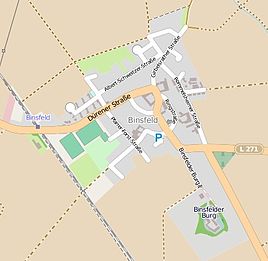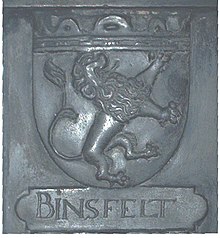Binsfeld (Nörvenich)
|
Binsfeld
Nörvenich municipality
Coordinates: 50 ° 47 ′ 41 ″ N , 6 ° 32 ′ 30 ″ E
|
|
|---|---|
| Height : | 135 m above sea level NHN |
| Area : | 9.63 km² |
| Residents : | 935 (May 31, 2020) |
| Population density : | 97 inhabitants / km² |
| Incorporation : | 1st January 1969 |
| Postal code : | 52388 |
| Area code : | 02421 |
|
Local plan of Binsfeld
|
|
Binsfeld is part of the municipality of Nörvenich in the Düren district in North Rhine-Westphalia .
location
Binsfeld is the westernmost part of the municipality and borders directly on the city of Düren . The Bördebahn runs on the outskirts .
Population development of the district
| Population development | |||||||
| year | population | year | population | year | population | ||
| 1885 | 629 | 1905 | 721 | 1925 | 890 | ||
| 1945 | 662 | 1955 | 1,029 | 1965 | 1,262 | ||
| 1975 | 824 | 1985 | 848 | 1995 | 883 | ||
| 2005 | 994 | 2010 | 949 | 2015 | 930 | ||
Until 1969, Rommelsheim was a district of Binsfeld.
history
Prehistoric finds suggest that people have been living in Binsfeld for thousands of years. Roman settlement remains were found west of the village.
Around 400 a decisive battle is said to have been fought near Binsfeld between the Romans, who have lived here for centuries, and the invading Franks . As the vernacular tells, the later found bones of the fallen warriors led to the name "Beinsfeld". More plausible is the scientific explanation of the place name, which derives from "field in the rushes ". Binsfeld thus describes a settlement area in a field which, according to its name, had a strikingly heavy vegetation with rushes.
On January 24, 966, Binsfeld is mentioned in a document by Emperor Otto I. It says that in 786 a girl named Ricburgis had given her property in Binsfeld in the land of the Ripuarians to an abbey in Nivelles (in today's Belgium). This affiliation lasted until the middle of the 16th century. The Lords of Binsfeld were evidenced as mayors of the Nivelles monastery for centuries.
In the Binsfeld parish church there is an epitaph with the life-size figures of Johann von Binsfeld and his wife Anna von Nesselrode . The epitaph was created in 1636. 16 ancestral coats of arms are attached to each of the pilaster strips .
As a Jülich subordinate, Binsfeld belonged to the office of Nideggen .
Towards the end of the 18th century it is reported:
"Unterherrschaft Binsfeld with high and low courts and hunting, with castle, courtyard, garden and tree garden, 148 acres of arable land, in treasure 33 Reichstaler 6 Albus , Pfennigsgeld 17 Reichstaler, then four geese, two stone flax, 19½ capons , 27 chickens, 13 Malter 6/4 3 Mütgen rye, oats 5/4, the traditional labor services , for which the fief holder 50 Reichstaler be paid by the municipality. Binsfeld was a subordinate and fiefdom, with Binsfeld from the 13th century to 1658 the family of the same name was enfeoffed, followed by the von Wachtendonk until 1720. The Düren district had a relatively large number of subordinates, such as Weisweiler, Binsfeld, Burgau, Drove, Maubach, Thum, Gladbach, Kettenheim Gürzenich, Merode and Frenz. "
The Binsfeld office, which was dissolved on December 31, 1939, had its seat in Frauwüllesheim. Until the merger with several neighboring communities to form the community of Nörvenich on January 1, 1969, the place Binsfeld had a district with Rommelsheim.
Second World War
South-southwest of the village, about 800 m southwest of the castle, in the corridor “Unter dem Maar am Mühlenweg” near the railway line of today's Bördebahn, there was a fully developed battery position for the west air defense zone . It consisted of 5 gun positions, a device position and 5 crew bunkers. 2 ammunition bunkers stood on the western edge of the railway line. About 250 m north of the main position was a second detached position with a gun post and crew bunker.
The battery warehouse is the hall to the southwest at the beginning of Dürener Straße, which was later used for cattle recycling and is now privately owned. After the Second World War there were apartments and the school here. On September 6, 1939, the position was occupied by the 1st battery of Reserve Flak Division 362. On November 26, 1944, the command post of the 353rd Infantry Division was in Binsfeld. The Americans took the civilian evacuated village on February 25, 1945. In a basement there was still a medical unit with several seriously wounded men, all of whom were taken prisoner.
The bunkers were blown up in June 1966.
After the war, the bunker facility was used by the Binsfeldern to deposit rubbish. After the 1775 m³ of garbage had been removed, 1442 m³ of topsoil was filled.
School system
In the Mairie Binsfeld [, paying a total of 934 souls,] (211 inhabitants, 41 school children in [Binsfeld itself]) with Rommelsheim (142 inhabitants. 33 school children), Frauwüllesheim (155 inhabitants, 34 school children), Irresheim (187 inhabitants, 48 school children ), Eggersheim (176 inhabitants, 38 school children), Bubenheim (30 inhabitants. 6 school children) and Isweiler (33 inhabitants, 9 school children) in 1814 was not even an ordinary village school. In the winter, the clergy who attended religious instruction tried at least to teach the children the letters, but otherwise the majority of the residents “or the real peasant class” (report by Mayor Ferd. Jansen) were indifferent to the school. The scattered small towns could hardly get through a teacher individually and the concentration of the individual towns into one school community was opposed by the distance between the towns (length of the mayor's office two and a half hours). Wealthy parents sent their children to Düren "into retirement".
A school building was built around 1850. In 1968 the Catholic elementary school was closed .
In the early days of compulsory schooling for children from six to twelve years of age, which had been compulsory in the Kingdom of Prussia since 1794, the sextons mostly taught the children. It took many years for compulsory schooling to prevail in the villages. The children mostly only attended classes from April to the end of October, as they were used in the other months for field work and housework on their parents' farms.
In 1855, lessons began with Michael Koerver, who only taught for one year. He was followed by Matthias Hülden from Hochkirchen , who was also sexton and organist at the parish church of St. Gertrud . He stayed until 1895. He was supported from 1872 to 1885 by Wilhelm Herzog, from 1878 to 1881 by Wilhelm Siepen from Isweiler , from 1877 for one year by Anton Mertens, from 1881 by Wilhelm Verken and from 1886 for one year by Heinrich Schlossmacher. Koerver was followed from 1895 to 1901 by the teacher August Reinartz. Peter Capellmann taught from October 1, 1901 to January 1, 1905. Heinrich Kirschgens followed him until his retirement on March 31, 1924. He was supported by Katharina Lenzen (July 1, 1910 to April 1, 1911), Maria Wilbert (April 20, 1911 to December 31, 1911) and Barbara Friedrich (January 1, 1912 to Easter 1928).
Long-time teacher Reinartz was followed by teacher Jakob Mehlkop, after whom a street in Binsfeld was named on the basis of the council resolution of April 4, 1978.
Mehlkop was born on April 28, 1893 in Aachen , was a teacher in Binsfeld from April 1, 1924 to September 30, 1958. He died on March 31, 1972 in Niederau .
During this time the following teachers worked at the Catholic elementary school in Binsfeld:
- Josephine Mai (April 1928 to May 1, 1928)
- Gertrud Meiser (11th Main 1928 to 31st January 1929)
- Anna Weisweiler (February 1, 1929 to July 1, 1950)
- Christine Felske (November 8, 1950 to June 11, 1951)
- Therese Schobert (June 20, 1951 to November 1, 1951)
- Franziska Sieben (November 1, 1951 to 1962)
After teacher Mehlkop followed
- Christian Roß (October 6, 1958 to January 15, 1959)
- Josef Claßen (1959 to 1967)
- Elisabeth Sacha (January 10, 1959 to August 5, 1959)
- Hermqann Schmitz (April 17, 1963 to April 23, 1965)
- Wolfgang Schäffner
- Mrs. Breusch
The Catholic elementary schools were closed in 1968.
The youth home of the Catholic parish was later added to the school building. There are two apartments on the first floor of the school that have been privately rented by the municipality. The two classes on the ground floor served as the village community center and branch of the Nörvenich music school, which no longer exists today. After the refugee crisis in 2015, refugees were housed in the youth home, apartments and a former classroom. A classroom was retained for the village community.
Others
Mary's Grotto (Lourdes Grotto)
The Mariengrotte in Binsfeld was built in 1911. It was a well-known place of pilgrimage, mainly for gypsies. It only lost its importance in the 1950s. Many votive tablets testify to healings.
Architectural monuments
See also
Partnerships
The Binsfeld volunteer fire brigade has had a lively partnership with the Holler fire brigade in northern Luxembourg for many years , which supplies the town of Binsfeld in the municipality of Weiswampach with fire services. The youth fire brigades from Binsfeld and Deifeld in the Sauerland often visit each other.
traffic
The Bördebahn runs on the outskirts . Since July 30, 2006, Binsfeld has had a stop on the railway line for the first time in its history. A train station with waiting halls was built at the end of 2019.
Personalities
- Dr. Ferdinand Breuer (1870-1946); Specialist in surgery and gynecology, chief physician at the Antonius Hospital in Cologne-Bayenthal , practice in Cologne's Severinsviertel - as a popular doctor he was “Dr. Two chair " called. He was the owner of the Groß-Ganshof in Binsfeld, owner of the Rheinfelder Hof, Margarethenhof and the Sandhof in Dormagen-Rheinfeld . In 1973 Faulgasse in Binsfeld was renamed Dr.-Breuer-Straße.
- Jakob Jansen (1815–1892), member of the Provincial Parliament
literature
- Binsfeld 966-2000 - 1100 years of village history in brief - by Karl Heinz Türk , Nörvenich 2009
- * Teacher at the former Catholic elementary schools in the Nörvenich community by Karl Heinz Türk, Nörvenich 1989
- Street names of the municipality of Nörvenich. Issue 3, published by the Nörvenich community, 1985
Web links
Individual evidence
- ↑ https://www.noervenich.de/gemeinde/einwohnerzahlen-monatlich/20200602-Einwohnerzahlen-05-2020.pdf
- ^ A b Günter Breuer: The place names of the Düren district, Shaker Verlag 2009, ISBN 978-3-8322-8475-6
- ↑ Home pages of the Dürener Zeitung, 9th volume, number 3, Thursday, February 4, 1932
- ↑ Martin Bünermann: The communities of the first reorganization program in North Rhine-Westphalia . Deutscher Gemeindeverlag, Cologne 1970, p. 77 .
- ^ From Binsfeld Castle, Rheinische Kunststätten by Marianne Hack
- ↑ "Bunkers in the West Air Defense Zone in the Rhineland and Hitler's headquarters in Bad Münstereifel-Rodert" by Manfred Groß, Meckenheim, 2001, pp. 158–161
- ↑ Elementary school teachers and elementary schools of the Jülich country in the Roer department around 1814, Volume 22 of the contributions to the history of the Dürener country, published by the Dürener Geschichtsverein e. V., 1995, p. 85
- ↑ Street names in the municipality of Nörvenich , Karl Heinz Türk, 1985, issue 3, p. 20





